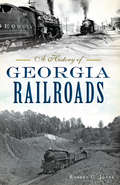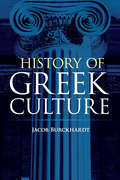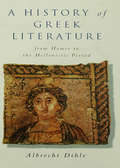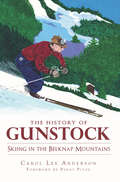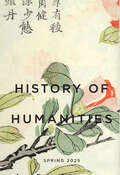- Table View
- List View
History of Georgia Railroads, A (Transportation)
by Robert C. JonesBefore the start of the Civil War, Georgia had ten railroads, five of which figured significantly in General William T. Sherman’s Atlanta Campaign and March to the Sea. The number of rail lines in the state ballooned after the war. Many were founded by individual entrepreneurs like Henry Plant and Thomas Clyde, while the biggest railroad of them all (Southern Railway) was created out of whole cloth by New York financier J.P. Morgan. At the close of the nineteenth century, consolidation was already in process, and by the end of the next century, only three significant railroads remained in Georgia. Author and historian Robert C. Jones examines Georgia’s rail history over the past two centuries and today.
History of Greek Culture
by Jacob BurckhardtThis monumental work by a distinguished European scholar presents a scrupulously realistic approach to ancient Greek civilization. Professor Burckhardt dispenses with superficial and sentimental views of ancient Greece to embrace a more sophisticated and accurate vision of a complex culture that practiced both the best and worst elements of the social contract. A penetrating thinker with a genius for concrete illustration, Burckhardt begins with a thorough account of the development of the polis, or city-state, exploring its regional variations and offering a balanced appraisal of its virtues and faults. In the second part, he discusses fine arts and their expression, with particular focus on sculpture, painting, and architecture. Part Three examines poesy and music, with an in-depth account of Homeric traditions and their role in maintaining the form and order of Greek beliefs and myths, as well as a consideration of other poetic forms, including the classical theater. The final part comprises perceptive accounts of numerous and enduring Greek achievements in philosophy, science, and oratory. In addition to an excellent glossary, the work is profusely illustrated with 80 photographs and many fine drawings.
History of Greek Literature: From Homer to the Hellenistic Period
by Albrecht DihleThe most up-to-date history of Greek literature from its Homeric origins to the age of Augustus. Greek literary production throughout this period of some eight centuries is embedded in its historical and social context, and Professor Dihle sees this literature as a historical phenomenon, a particular mode of linguistic communication, with its specific forms developing both in an organic way and in response to the changing world around. In this it differs from conventional humanist approaches to Greek and Latin literature which analyse the works as objects of timeless value independent of any historical setting or purpose.This magisterial survey by one of the leading European authorities on classical literature will establish itself, as it already has in Germany, as the standard account of the subject.
History of Gunstock, The: Skiing the Belknap Mountains (Sports)
by Carol Lee AndersonBefore it became home to generations of skiers, Gunstock Mountain began as a Works Progress Administration recreation project during the Great Depression that transformed the small farming community of Gilford into one of central New Hampshire's most renowned skiing resorts. Join local ski historian Carol Anderson as she takes on the triumphs and defeats of four high-altitude jumps and the history of the snowy trails of the Gunstock Mountain Resort. Approaching its seventy-fifth anniversary, Gunstock has molded the careers of champion skiers and Olympians, including two-time silver medalist Penny Pitou, ski icon T. Gary Allen and the ski jumping sensation Torger Tokle. Anderson pays tribute to those individuals who have worked, skied or played a part in this iconic mountain of the Lakes Region.
History of Humanities, volume 10 number 1 (Spring 2025)
by History of HumanitiesThis is volume 10 issue 1 of History of Humanities. History of Humanities, along with the Society for the History of the Humanities, takes as its subject the history of a wide variety of disciplines including archaeology, art history, historiography, linguistics, literary studies, musicology, philology, and media studies, tracing these fields from their earliest developments, through their formalization into university disciplines, and to the modern day. By exploring the history of humanities across time and civilizations and along with their sociopolitical and epistemic implications, the journal takes a critical look at the concept of humanities itself.

